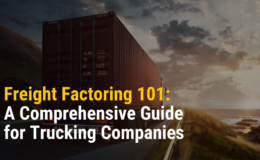The two most important considerations when looking into a new factoring agreement are your freight factoring rate and advance rate. We’ll focus on the factoring rate in this article.
When a factoring company provides you with a rate, they consider how much risk they will take when extending credit to you and your freight volume.
Determining Your Eligibility to Factor
When determining a carrier’s risk, a factor will often look at the stability and history of the carrier, the diversity of the carrier’s customer base, and the owner’s credit history.
When considering a carrier’s volume, they will look at the number of invoices you submit and the total worth of your invoices.
With that in mind, there are three common factoring rate types that you and your factoring company have on the table:
- Flat Rate
- Tiered or Variable Rate
- Rate by Volume
Below is a description of each of the three rate types, examples, and the pros and cons for each:
Flat Rate
A flat rate is the most common rate structure among owner-operators and fleets because it’s the most straightforward and predictable.
With the flat rate, the percentage you pay on each factored invoice is always the same. The rate is consistent regardless of your volume and how fast or slow your customers pay the factoring company. (This can vary based on whether you have a Recourse or a Non-Recourse Agreement. You can read more on that here.).
Flat rates typically range from 2% to 3%. However, your flat rate should generally be no higher than 3%.
This rate structure is also the most consistent and predictable. A flat rate protects you against slower or late-paying customers and lets you know precisely what your monthly fee will be.
The potential drawbacks of this approach are that you may be eligible for better rates with one of the other approaches if your volume increases significantly over your contract or if you have customers that pay quickly.
Even with a flat rate, ask about any other hidden charges in the factor’s contract. Some factoring companies will “bait and switch” you with a low upfront rate but include lots of hidden fees on the backend.

How to Calculate a Factoring Flat Rate
Using a flat rate on an invoice valued at $1,500, your factoring company charges a fee typically ranging from $150 per invoice (1% fee) to $45 per invoice (3% fee).
It is worth noting that you do not pay this fee to your factor directly. The cost is deducted from the invoices and the factoring company funds from your brokers or shippers.
| Invoice Amount | $1,500 |
| Factoring Rate | 2.3% |
| Total Factoring Rate Fee | $34.50 |
| Amount Paid to You* | $1,465.50 |
* Note: There may be Wire, ACH, or Fuel Card Load fees deducted. If you submit multiple invoices at once, you should only pay those fees once, not per invoice. Wires Range from $8-$20, ACHs range from $5-$10, and Fuel Cards vary based upon the provider but are generally $4-$5 or less.
Tiered or Variable Factoring Rate
The second approach is a tiered or variable rate. With this approach, the rate you pay on each invoice will change depending on how faster your customers pay your factoring company.
When you sign your contract, you’ll agree with your factoring company on the rate structure upfront. Here’s an example of what a tiered or variable rate structure might look like:
- If your customer pays within 15 days, the fee is 1%
- If your customer pays within 20 days, the fee is 1.75%
- If your customer takes between 30 and 45 days to pay, the fee is 2.5%
- If your customer takes between 45 and 60 days to pay, the fee is 3%
- If your customer takes over 60 days to pay, the fee is 4%
The main advantage to this approach applies if you have customers that pay quickly, typically under 30 days. You’ll often be able to secure lower rates vs. a flat rate in that case.
However, with the tiered or variable approach, if your customers are late paying their invoices to your factoring company, even a few, you may end up paying more in fees than you would a flat rate approach.
How to Calculate a Tiered or Variable Factoring Rate
Let’s again suppose you invoice $15,000 for two months in a row. In the first month, your customer pays in 15 days, but in the second month, your customer pays in 45 days. Here’s how that would look each month.
Month 1
| Monthly Invoice Total | $15,000 |
| Invoice Paid Date | 15 days |
| Factoring Rate | 1% |
| Total Factoring Rate Fees | $150 |
Month 2
| Monthly Invoice Total | $15,000 |
| Invoice Paid Date | 45 days |
| Factoring Rate | 2% |
| Total Factoring Rate Fees | $300 |
Factoring Rate by Volume
With a rate-by-volume approach, your factoring company will base your rates on the total amount of the invoices you submit each month.
Again, you’ll agree on these rates with your factoring company upfront. As an example, your rates might look like the following:
- 3% if you submit less than $25,000 in invoices per month
- 2.75% if you submit between $25,000 and $75,000 per month
- 2.5% if you submit between $75,000 and $150,000 per month
- 2.0% if you submit more than $150,000 per month
This approach is ideal for fast-growing businesses that anticipate growing their business or fleet over their contract term, typically 12 months.
If the amount you plan to factor will remain relatively constant over your contract, it’s typically more straightforward to go with a flat rate.
How to Calculate Factoring Rate by Volume
Let’s say the first few months of your contract, you’re factoring less than $25,000, but by the end of your term, you’re up to $35,000 in monthly invoice volume.
Here’s how that situation might look.
Month 1: $15,000 in invoices factored
| Monthly Invoice Totals | $15,000 |
| Factoring Rate | 2.75% |
| Total Factoring Rate Fees | $412.50 |
Month 9: $35,000 in invoices factored
| Monthly Invoice Totals | $35,000 |
| Factoring Rate | 2% |
| Total Factoring Rate Fees | $700 |
It’s Important to Note: No Two Factoring Contracts Are the Same
Factoring companies help owner-operators and larger fleets maintain a consistent cash flow for their daily operations and help support future growth.
Remember that even though two factoring companies offer the same rate structure, your total factoring fees might differ depending on hidden fees and other considerations. Talk to one of our experts today about the best approach for your business.







